How to stop gout pain fast and get immediate relief?
Gout is a very painful condition sometimes referred to as the disease of the kings because it is associated with protein rich diet (meat and wine). This post is a detailed, evidence based guide to causes, symptoms and medical and home remedies for gout. Detailed instructions and pictures are included. If you suffer from this disease always go and see your doctor to get proper treatment. You may show your physician some tips on how to relieve gout featured in this article and ask him/her to select the best treatment option for you.
What is gout?
Gout is a metabolic, inflammatory disorder in which abnormally high levels of uric acid in the blood accumulate in joints (1, 2). The chief cause of gout is defective metabolism of purine (a nucleic acid). In normal circumstances, purine is metabolized by body into uric acid and later on excreted through kidneys. In this metabolic disorder, however, metabolic defects cause uric acid is overproduced but is not excreted properly. In almost all cases, gout develops due to the inadequate rate of excretion of uric acid via kidneys. When level of uric acid in blood is abnormally high, it leads to the formation of urate crystals which are needle shaped. The uric acid arranges itself in needle-like crystals in joints and produces redness, severe pain, tenderness and swelling. Urate crystal deposition irritates the lining of joints and triggers painful joint inflammation. This is also known as an acute gout attack. The urate crystal deposit in joints is called tophus. The big toe joint is affected in about three out of four gout patients, but any joint can be affected including the ankles, wrists, knees or elbows. Women, especially, have a tendency to develop gout in the hands.
Here is a picture explaining what gout is in an easy to understand way:
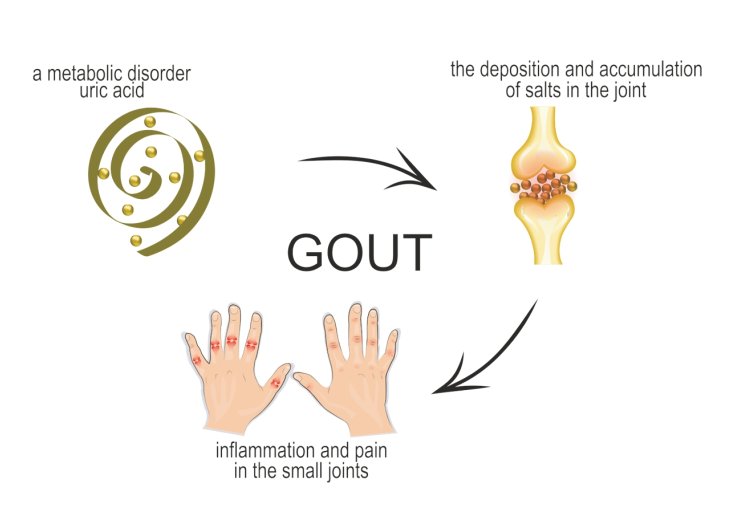
Biochemically, gout is characterized by high levels of uric acid in blood (hyperuricemia) and clinically by episodic attacks of extremely painful, acute arthritis. Hyperuricemia is called primary, when it is blood uric acid levels spike due to a metabolic defect that leads to an increased rate of production of uric acid and low excretion rate; or secondary, when it develops as a consequence of another disease or as side effect of some drug.
Stages of gout
A gout attack proceeds in four stages:
- Asymptomatic hyperuricemia takes place before the first stage. No symptoms are visible but uric acid level is high and its molecules arrange into needle like crystals at joints.
- An acute gout attack takes place when a trigger (such as high alcohol consumption throughout the night) raises blood uric acid levels to or prods the uric acid crystals that have accumulated at a joint, initiating the attack. The subsequent pain and inflammation mostly hit at night and worsen over the next ten to twelve hours. The severity of symptoms decreases after a few days and pain disappears after a week to ten days. Some gout patients never suffer from a second attack, but about 60% of patients have more than one attack within a year.
- Interval gout is the stage or hiatus between two attacks. Even though there is no pain, the symptoms are not completely absent. There still might be low level inflammation at joints. At this stage you should begin managing gout – through alteration sin lifestyle and medication – to avoid recurrence of attacks or development of chronic gout.
- People who have high blood uric acid levels over a number of years develop chronic gout. Frequency of attacks increases and the pain may never really completely disappear. Damage to joints results in a decrease in mobility. Through proper care and treatment, this stage can be avoided.
An estimated 4% of Americans suffer from gout – this includes nearly 5 million men and 3 million women. You are more likely to experience a gout attack if you have a family history of this disease.
Gout is more common in elderly people. Usually, the first gout attack takes place at the ages 40-60. Women usually develop gout after menopause.
Causes of gout
Gout develops as a result of hyperuricemia or extra production of uric acid in the body (3). Other factors, such as consuming foods having a high purine content, obesity and heavy drinking – especially excess beer consumption – are even involved in producing hyperuricemia and gout. Gout is divided into primary and secondary categories, depending on the causative factor behind hyperuricemia or high levels of uric in blood.
Majority of primary gout cases are referred as idiopathic. It means that the causative factor behind them cannot be determined. Primary gout is usually the result of a blend of hormonal, genetic and dietary factors.
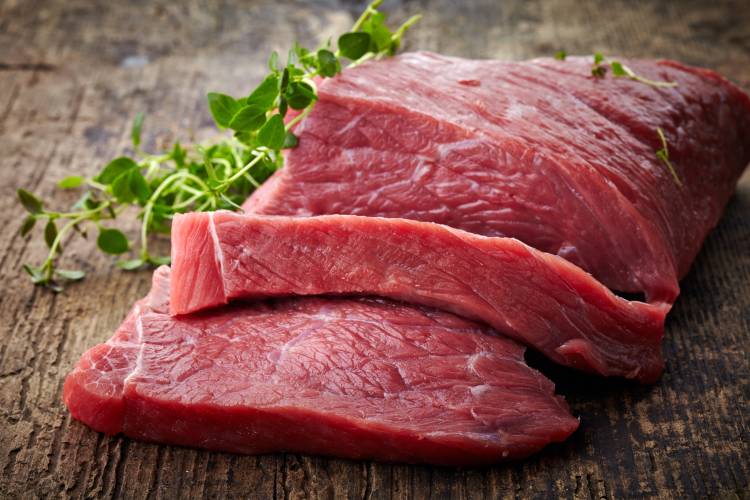
Secondary gout is usually a consequence of a medical disorder or drug therapy.
Gout triggers and risk factors
There are a number of factors that can increase risk of gout. For treatment of gout and proper diagnosis, these risk factors should be kept in mind (4, 5, 6).
Some medical factors that can trigger onset of gout are:
- Hyperuricemia. It is characterized by a serum uric acid above 6.8 mg/dL. Hyperuricemia is the metabolic backdrop for a gout attack. For those suffering from gout, the aim is to maintain serum uric acid level lower than 6.0 mg/dL, and less in those with chronic gout or advanced disease.
- Any type of injury to joint. Urate crystals are more predisposed to accumulate in a joint that has suffered previous injury. New injuries can also exacerbate symptoms.
- Trauma or surgery
- Infection
- Use of diuretic drugs for treatment of hypertension (high blood pressure), edema in legs or cardiac disease.
- Cyclosporine therapy
- Chemotherapy
- Bed rest, often post-operative
- Uric acid lowering treatment without anti-inflammatory coverage.
A certain mode of living can also lead to gout:
- Fasting
- Crash diets including high protein fad diets
- High alcohol intake
- Diet consisting of food items having high purine content
- Inadequate intake of fluids and dehydration
- Drinking too many fizzy drinks
- Long term professional exposure to lead is connected with increase of uric acid and gout.
Gout can also be a consequence of a preexisting medical disorder, such as:
- High blood pressure or hypertension. The link between gout and hypertension is a group of drugs called diuretics, which are frequently used to treat high blood pressure and heart failure. As diuretics elevate the sodium and water excretion rate of body, this decreases pressure on vessel walls, thus alleviating blood pressure. But, this can lead to an increase of uric acid level in blood, which may eventually cause gout. Other anti-hypertension drugs, such as ACE inhibitors, may also cause gout (see below for further info).
- Renal disease
- Diabetes
- Osteoarthritis
- High blood cholesterol level
- A combination of high blood pressure, diabetes and being overweight called metabolic syndrome
- Obesity. An individual having a Body Mass Index (BMI) of 30 or more is considered overweight and is at higher risk of developing gout. Researchers report a clear link between body weight and uric acid levels. In one Japanese study, overweight people had two to more than three times the rate of hyperuricemia as those who maintained a healthy weight. Children who are obese may have a higher risk for gout in adulthood.
- Psoriasis (a skin disease in which skin becomes covered with scarlet patches with silvery flakes.
Gout may be caused by some medical drugs, such as:
- Diuretics (water tablets). These are a part of high blood pressure therapy or are used to treat abnormal buildup of fluids inside body.
- Some drugs such as ACE inhibitors or beta blockers used to treat hypertension also increase risk of gout.
- Niacin which is used to lower cholesterol level.
- Aspirin which is used to treat abnormal blood clots. Low doses of aspirin decrease uric acid excretion and amplify the possibility for hyperuricemia. This can especially be a problem for elderly people who take low potency baby aspirin (81 mg) for protection against cardiac disease.
- Some cancer medicines.
- Pyrazinamide (a drug used to treat tuberculosis)
- Cyclosporine which is used to treat psoriasis
Diet, e.g. eating foods naturally high in purine, such as:
- Red meat including beef, lamb and pork.
- Offal – such as kidneys, liver and heart
- Seafood particularly shellfish and oily fish
- Excessive alcohol intake. Alcoholic drinks can elevate the amount of uric acid in blood. Beer and fortified wines such as port are especially significant in this regard. Reasonable consumption of wine – a glass each day – does not increase the risk of developing gout. Alcohol use is a major cause of development of gout in young adults. Binge drinking significantly increases blood uric acid levels. Alcohol has been observed to have less a part in triggering a gout attack among elderly patients, particularly among female gout patients. Alcohol increases uric acid levels in the following three ways:
- Increasing amount of purines in diet (the nucleic acids from which uric acid is produced).
- Elevating the body's uric acid production.
- Decreasing the efficiency of kidneys in excreting uric acid.
- Carbonated drinks. Some sodas and sugary drinks can also increase the risk of a gout attack. Some studies have shown that drinking sugary, fizzy soft drinks and drinks having high levels of fructose increased chances of developing gout.
Family history
Research has shown that gout sometimes runs in families. People who have gout patients in their family have a higher possibility to experience a gout attack. About 30% of gout patients present a family history of gout. Three genetic locations have been connected with the metabolism of uric acid in body and gout. Some patients with a preexisting family history of gout have a malfunctioning enzyme that interferes with the metabolism of purines and their break down. Gout clusters in families and is more common in some Asian sub groups such as Maoris and Pacific Islanders.
Age
Gout can affect all age groups, but it usually occurs in men over forty years of age and post-menopausal women. Middle aged men are most commonly affected by gout, peaking in the mid to late-40s. Incidence of gout in this age group is mostly associated with obesity, high cholesterol levels, high blood pressure, and smoking and excessive alcohol use.
Gout also affects older people. The incidence is almost equal in men and women of this age group. In them, gout is most often caused as a consequence of renal disease and the use of diuretic drugs. Alcohol plays an insignificant role.
Gout rarely occurs in children. The only children who suffer from gout are the ones who have genetic uric acid metabolic disorders causing hyperuricemia.
Gender
Men are more prone to having a gout attack than women. But once women are post-menopausal, their possibility of developing gout increases. Men are at considerably higher risk of having a gout attack. In men, uric acid levels increase significantly at puberty. In about 6- 8% of American males, levels rise higher than 7 mg/dL (resulting in hyperuricemia). But gout usually strikes after 20 - 40 years of continual hyperuricemia, so men who develop it mostly suffer from gout in middle age.
Before menopause, women have a considerably lesser risk for gout than males, probably because of the effects of estrogen. Estrogen appears to assist uric acid excretion by the kidneys. (Only a small percentage of gout cases in women develop before menopause.) At age 60, incidence of gout is equal among males and females, and after 80 years of age, gout affects women more than men.
Ethnicity
The incidence of gout and co morbid conditions is different among different ethnic groups. For example, in the United States, African Americans and Latinos who show symptoms of metabolic syndrome are more prone to gout.
Symptoms of gout
The most important symptom of gout is a sudden attack of extreme pain in joints. It can be one joint or more. Pain usually arises in big toe (3).
Other symptoms may include:
- Tenderness in joint. It feels very hot. It becomes tender to the extent that it can’t bear anything touching it.
- The area inside and around affected joint becomes swollen.
- The skin over affected joint becomes red and shiny.
- As the swelling goes down, skin becomes flaky, scaled and itchy.
- The severe pain can make mobility difficult. Even light contact with blanket or bed cover can be painful.
Gout can affect any joint in the body and can occur in many joints simultaneously. The joints articulating at end of limbs are more vulnerable to a gout attack, including:
- Middle of foot, where shoelaces are tied
- Toes, especially the big toe.
- Knee joint
- Ankle joint
- Wrist joint
- Fingers
- Elbow joint
If gout is not paid attention and left untreated, it may eventually affect other joints too.
Gout attacks usually take place at night, although they can occur at any moment. They develop suddenly and rapidly over a span of few hours. The symptoms last for about a week or ten days but may persist if not treated properly. You may possibly experience gout attacks every few months or every year. Their frequency and intensity increases over time if gout is left untreated. It's difficult to foretell frequency of attacks or when they will take place.
Treatment of gout
First step in gout treatment is pain management (6, 7).
You should:
- If you have already suffered from a gout attack and have been prescribed a painkiller, start taking the analgesic as soon as possible. It will help manage the pain over two to three days.
- Keep the limb in an elevated position and allow it to rest.
- Avoid exerting any stress or trauma of any sort to the affected joint.
- Keep the affected area cool. Remove clothing over affected joint and apply an ice pack or something cold, for example a bag of frozen peas wrapped in a towel.
- Make sure that you are well hydrated.
- The ice pack should be applied directly to affected joint for twenty minutes. Don't place the ice pack directly onto skin or it will damage it.
- If the need arises, you can keep putting an ice pack on your skin during an attack. Just wait until your skin has returned to a normal temperature first.
Medical drugs used for treatment of gout
NSAIDs
The first line treatment for gout includes non-steroidal anti-inflammatory drugs or NSAIDs (7). They reduce pain and inflammation during a gout attack.
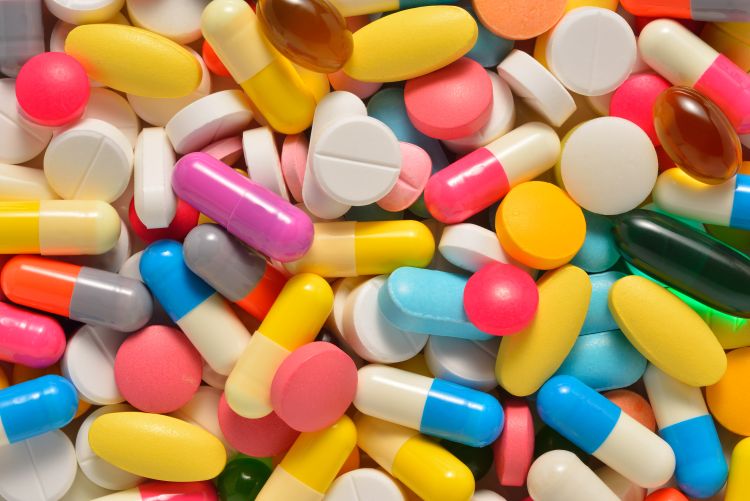
The NSAIDs that doctors prescribe for gout are diclofenac, naproxen and etoricoxib.
If your doctor has prescribed NSAIDs, it is recommended that you have them with you at all times so you can have them at hand as soon as a gout attack starts. Take your medication during the gout attack and for two days after it.
Your doctor may also prescribe a proton pump inhibitor (PPI), to take with the NSAID. This lowers the risk of the NSAID causing adverse effects such as stomach ulcers, indigestion and gastric bleeding.
Colchicine
If NSAIDs are proving ineffective for you or you are allergic to them, another drug called colchicine can be used. Colchicine decreases inflammation and pain experienced during a gout attack (8). It’s a good idea to have colchicine with you at all times in case you suffer from a gout attack. Your doctor will advise you about dosage and duration of therapy.
If taken in high doses, colchicine causes side effects such as nausea and vomiting, abdominal or stomach pain and diarrhea.
Corticosteroids
Corticosteroids are used in patients for whom NSAIDs and colchicine don’t work or who cannot take these drugs (9). They are used short term for providing relief from gout pain, but they are not suitable for being used long term as they cause a number of serious side effects such as thinning of bones, easy bleeding and bruising, weight gain and muscle weakness.
Besides oral route, corticosteroids are also injected to provide rapid pain relief. The medicine can be injected into a muscle, a vein or directly into the inflamed joint.
Allopurinol
People suffering from recurrent attacks of gout or complications of gout are usually prescribed medication to reduce uric acid level in body- this is called as urate lowering therapy or ULT (10). Majority of gout patients require urate lowering therapy at one point or another so it’s a good idea that you discuss its advantages and disadvantages with your doctor as soon as you are diagnosed with.
ULT significantly decreases probability of future gout attacks. Most people have to undergo ULT for the rest of their lives and it rarely causes side effects. Allopurinol is the first drug of choice in ULT. Febuxostat is prescribed to patients allergic to allopurinol.
Benzbromarone and sulfinpyrazone are less commonly used ULT medicines. These types of drugs are only used in cases where patients are unable to take allopurinol and febuxostat. These medications should only be used after consultation with a specialist.
Allopurinol acts by reducing the excess production of uric acid. It helps in prevention of gout attacks but it does not have any effect on the symptoms. An allopurinol tablet is taken once a day for treatment of gout. The dose needs some adjustment in the beginning. The most effective dosage is found out by regular blood tests and monitoring body uric acid levels. Allopurinol may sometimes trigger a gout attack and may take a year before gout attacks completely stop. It is essential to carry on with treatment even if you do have gout attacks during this time.
To help relieve symptoms such as pain and inflammation, your doctor will most probably prescribe an analgesic or pain killer along with allopurinol. A lot of people taking allopurinol don’t experience any significant adverse effects.
However, sometimes gout patients may experience side effects such as:
- A rash. The rash is usually a mild one but it may be a red light that you are allergic to allopurinol. In case a rash develops, stop taking the medicine immediately and contact your doctor for further advice.
- Abdominal pain
- Headache
- Indigestion
- Nausea
- Diarrhea
Febuxostat
Like allopurinol, this is a drug taken orally once a day and it reduces production of uric acid in body. Febuxostat is used in patients who are allergic to allopurinol or who are not getting any relief from its use (11).
As is the case with allopurinol, febuxostat can exacerbate your gout symptoms when you initially start taking it. In the beginning of therapy, your doctor will prescribe an analgesic medicine along with allopurinol to alleviate pain and inflammation.
Adverse effects of febuxostat may include:
- Nausea
- Indigestion
- General feeling of illness
- Headache
- A mild rash
Gout surgery
In cases where there is lack of effective gout treatment, surgery is required to treat severe joint damage. Tophi can also be removed through surgery (12).
Lifestyle changes as gout treatment and to prevent further attacks
You can reduce risk of experiencing further gout attack by making certain lifestyle changes such as (13, 14, 15):
- Remove food items having high levels of purine (the nucleic acid involved in production of uric acid) from your diet, such as shellfish, offal, red meat for example beef, seafood, oily fish and foods containing yeast extract. You can consult a dietician or nutritionist in this matter and get a complete list of foods to avoid.
- Avoid drinking fizzy, sugary drinks and eating sugary snacks. These increase the risk of a gout attack.
- Maintain a healthy diet. Follow a nutritious, healthy and balanced diet. Avoid crash diets and don’t try high-protein, low-carbohydrate diets.
- Exercise regularly to enhance stamina of your body. Don’t try activities that put too much strain on your joints.
- Increase intake of fluids and drink plenty of water. Staying hydrated will reduce chances of urate crystals forming in your body.
- Cut down consumption of alcohol. Do not binge drink and avoid beer and spirits in particular.
- Some studies suggest that taking vitamin C supplements or increasing intake of foods rich in vitamin C can reduce risk of gout but the effect will be small. If you are considering taking vitamin C supplements, consult with your doctor first because they are not suitable for everyone.
- Control your cholesterol levels and take a low fat, low cholesterol diet. Heart disease increases chances of gout attack. A low fat diet will decrease risk of both cardiac disease and gout.
- Do not try crash diets and lose weight slowly. This will help lower your uric acid levels. Trying to lose weight rapidly can trigger a gout attack.
- Increase dairy products in your diet, such as yogurt and skimmed milk. Dairy products can lower risk of gout attacks.
- Avoid foods with fructose, for example corn syrup.
- When you are diagnosed with gout, inform your doctor if you are taking drugs such as diuretics, cyclosporine or baby aspirin because these drugs aggravate gout.
If you are suffering from gout, you should make changes in your lifestyle to decrease uric acid production and follow advice of your doctor.
Ideal prevention of gout attacks may involve medical therapy for the rest of your life.
Here is a cartoon summarizing gout treatment steps:
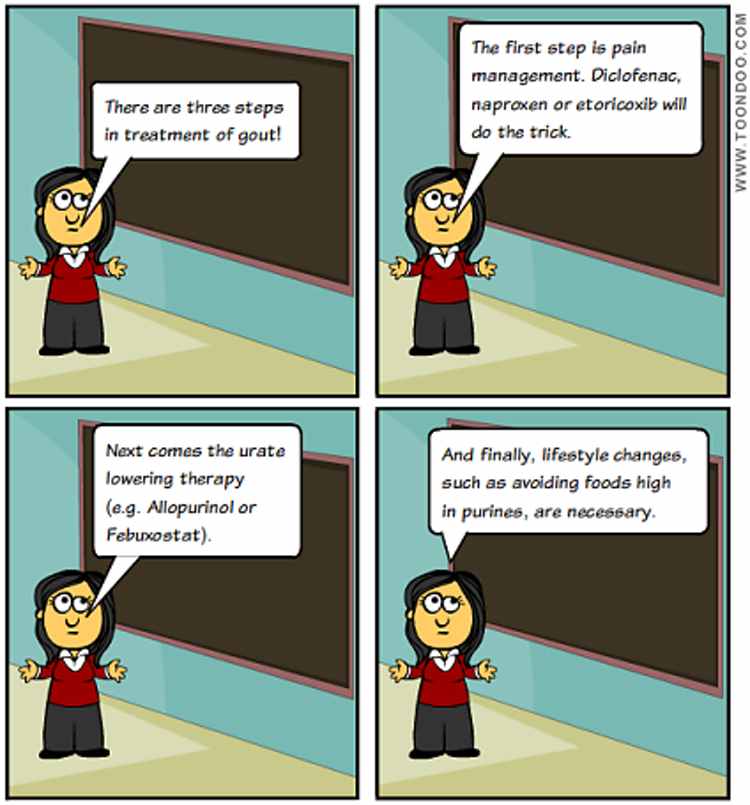
Home remedies for gout
Internet is full of "proven" home remedies for gout. However you should be aware of the fact that there is very limited evidence that these remedies actually work. The best gout treatment is always a combination of lifestyle changes (see above) and proper medicines (pain relievers, Colchicine, Allopurinol, etc.). You should always go and see your doctor if you suffer from gout attacks and you should never rely on information found on the web.
Below we feature some home remedies, which may be used in treatment of gout in addition to (and not as a substitute for) proper medical treatment and lifestyle changes.
According to Dr. Edwards these remedies may have some minor effect in gout treatment.
Apple cider vinegar
Apple cider vinegar has lots of medicinal benefits. It helps in gaining relief from gout and arthritis.
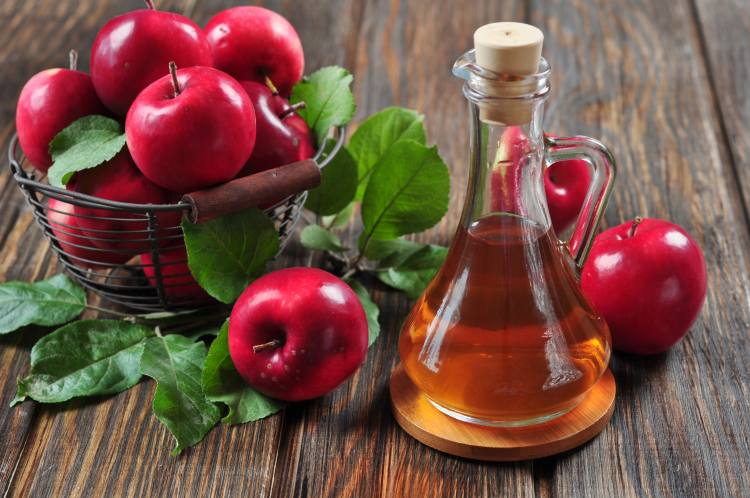
It relieves acute pain experienced during a gout attack due to its acidity. You can take it with honey to augment anti-inflammatory response of your body.
How to use apple cider vinegar for gout treatment?
Mix one teaspoon of unfiltered, pure, raw apple cider vinegar in a glass of water. Drink this mixture two times every day. Take some honey with it if you want. If you find this remedy effective, increase the quantity of apple cider vinegar.
Ginger root
The anti-inflammatory traits of ginger root make it a powerful remedy for treating gout pain and inflammation.
Ginger root can be used in various ways to treat gout such as:
- Combine equal quantities of fenugreek powder, dried ginger root powder or sonth and turmeric powder. Mix one tablespoon of this powder into a glass of warm water and drink it daily.
- You can directly add ginger root powder into your meals while cooking. You can also eat a small, raw piece of ginger root every day to treat gout.
- Mix half a teaspoon of ginger root powder into a cup of boiling water and mix it well till it is dissolved completely. Drink this mixture once daily.
- Another method is to prepare a paste of ginger root powder with a little water and apply this paste on the affected joint. Leave it on for about thirty minutes. Do this once every day.
Baking soda
Excess production of uric acid is a significant factor contributing to onset of gout. Baking soda can help decrease the production of uric acid in body.
How to use baking soda to treat gout?
Take a glass of water and mix half a tablespoon of baking soda in it. Drink this mixture three to four times a day but not more than that. Continue this process for two weeks until you feel better.
If you are aged above 60 years, do not take this remedy more than three times a day. Also, avoid this remedy if you are a patient of hypertension and suffer from high blood pressure.
Lemon juice
To obtain relief from gout pain, it is important to alkalize the body and neutralize the high levels of uric acid in blood stream.
Fresh lemon juice and baking soda can do this task.
How to use lemon juice as home remedy for gout?
- Mix the juice extracted from one lemon with half a teaspoon of baking soda. Wait for the fizzing to stop for a few seconds. After that, mix it in a glass of water and drink immediately.
- Another method is to mix the juice of half a lemon in a glass of warm water and to drink this solution three times a day.
- Besides lemon juice, also eat other fruits with high content of vitamin C to strengthen the body tissues against gout.
Cherries
Due to their potent antioxidant properties, cherries are well equipped to fight inflammation of gout.
Anthocyanins are also present in cherries, which can alleviate inflammation and prevent gout flare ups.
How to use cherries to alleviate gout pain?
- Eating fifteen to twenty cherries every day is very beneficial for gout patients. For optimal results, begin your day with some cherries.
- Another way is to drink a glass of black cherry juice daily. Adding a few minced garlic cloves into it will enhance its therapeutic value.
Epsom salt
Epsom salt is also an effective ingredient for treating gout and arthritis at home.
Epsom salt is rich in magnesium and boosts improve cardiac health and lowers hypertension. Having an Epsom salt bath relaxes inflamed joints and provides relief from pain to affected areas.
How to use epsom salt for gout?
For a leisurely soak, dissolve two cups of Epsom salt into warm bath water. Soak in this soothing bath until the water gets cold. Have an Epsom bath once a week. If you are suffering from severe case of gout, you can try it two to three times a week.
Bananas
Bananas are also an effective remedy for treating gout.
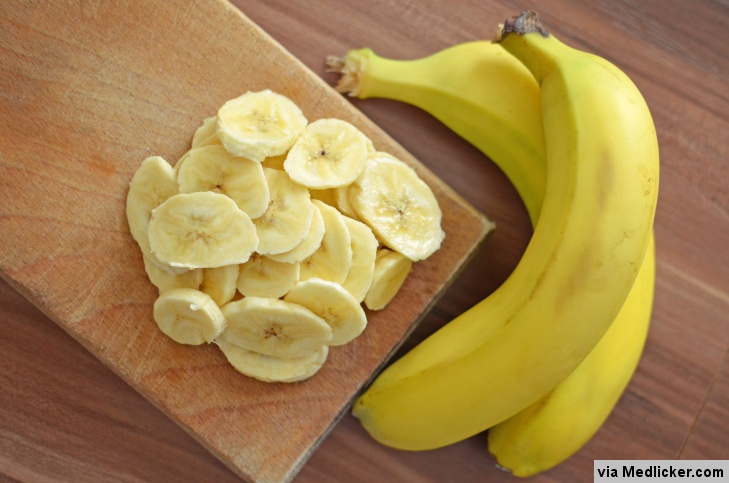
The rich potassium content in bananas convert uric acid crystals into liquid form that is easily flushed out from body. Bananas also have small amounts of vitamin C present in them, which helps alleviate pain, discomfort and inflammation experienced in a gout attack.
How to use bananas as gout remedy?
Just include one or two bananas into your daily diet, and you will soon notice improvement in your condition. You can also add a ripe banana to half a cup of yogurt. This will help in treatment of gout.
Apples
A healthy diet is a sure fire way to prevent gout and inclusion of apples into this diet plan will greatly help in prevention of gout attacks.
How to use apples for gout?
Nutritionists recommend eating an apple after very meal.
Apples have malic acid present in them which neutralizes effect of uric acid and thus reduces pain and inflammation.
You can opt for apple juice if you do not like eating apples. It is a good idea to add some carrot juice in your apple juice to boost its medicinal effect.
Activated charcoal
Activated charcoal absorbs excess uric acid present in body and hence helps in treatment of gout. Gout patients are advised to take a charcoal bath once or twice a week.
For treatment of gout using charcoal, prepare a paste by mixing half a cup of charcoal powder with some water. Add the paste in a tub and pour in more water. Soak your affected body part for about thirty minutes in this charcoal bath. This remedy is a particularly good option for gout pain in ankle or big toe.
For other areas of body affected by gout, you can prepare the charcoal paste mentioned above and apply it over affected area or joint. Leave it on for thirty minutes and then wash it off with lukewarm water.
Another option is to take activated charcoal capsules orally to reduce gout pain and inflammation. Do not take these capsules without consulting your doctor first.
Cold water
Soaking the affected area in cold water will help bring down swelling and reduce pain. If you are a gout patient, do not apply ice directly to affected area as it will damage your skin.
How to use cold water as gout pain relief?
- Soak the inflamed, painful, swollen joint in cold water for about fifteen minutes. Repeat this process three to four times a day or whenever the pain flares up.
- You can apply an ice pack for about ten minutes, but wrap it in a cloth or towel before placing it on the affected joint. Repeat this process two times a day. Do not use ice packs excessively because their application may cause crystallization of uric acid.
Other remedies
- For treatment of gout, try some bromelain. Bromelain is a compound found in pineapples. It is also available in supplement form. The enzymes in it have been found to be useful people suffering from gout and have even been known to have anti-cancer properties.
- Drink beet juice. Beet juice helps prevent acidosis and facilitates excretion of uric acid.
Precautions
Gout can be treated both through drug therapy and natural, home remedies. While choosing treatment options, it is important to bear in mind these precautions:
- Do not start any drug for treatment of gout without prior consultation with your doctor.
- Do not take corticosteroids for a long duration of time as they can cause serious side effects such as thinning of bones and muscle weakness.
- Use of NSAIDs should be avoided in patients of ulcer as it causes gastric bleeding. They used also be sued carefully in patients suffering from cirrhosis, preexisting kidney disease or congestive heart failure.
- Inform your doctor about your complete medical history especially if you are taking diuretics, low dose aspirin or cyclosporine.
- If mild rash appears during allopurinol or febuxostat use, stop their use immediately because it might be warning sign of allergic reaction. Do not continue use until your doctor says so.
- Allopurinol use may cause drowsiness. Do not take this medicine before driving or operating heavy machinery. Consult with your doctor at once if you notice pain or tenderness in the upper abdominal area, discoloration of stools, dark urine, nausea, unexplained fatigue and weakness and yellow discoloration of eyes and skin. These could indicate serious liver damage.
- People using colchicine for treatment of gout face an increased risk of infection because it temporarily lowers amount of white blood cells in body. It may also reduce the number of platelets, which are essential for proper blood clotting. Therefore, avoid interaction with people with infection as much as possible.
- Visit your doctor immediately if you think you have contracted an infection or if you experience chills and fever, sore throat and cough, painful spasms in lower back, or difficult and painful urination.
- Consult with your doctor at once if you observe any irregular bleeding or bruising, bloody urine or stools, discolored and tarry stools, or pinpoint red spots on your skin. Avoid situations or activities where bruising or injuries could occur.
- Do not use baking soda for treatment of gout if you suffer from hypertension.
- Do not apply ice directly to skin of affected area because it can damage skin.
FAQs concerning gout?
When should I visit my doctor?
Consult your doctor immediately if you have sudden onset of pain in a joint area and there is swelling in joint with tenderness and red skin appears over them.
Should I continue ULT even if attacks continue to occur?
ULT or urate lowering therapy is a long term treatment course for gout and gout attacks may take place till a year or so. Consult your doctor if you feel that the medication is ineffective.
Things to remember
Treatment options for gout are NSAIDs, corticosteroids, colchicine and ULT drugs such as allopurinol and febuxostat. Keep in mind side effects of these drugs before using them.
Home remedies also provide relief from gout pain and inflammation and some remedies also help prevent excess production of uric acid in body. Popular home remedies for gout treatment include apple cider vinegar, Epsom salt bath, cherries, apples, bananas, baking soda etc.
It is important to make changes in your lifestyle to prevent gout attacks. Lose weight and exercise regularly. Increase water intake and stay hydrated. Cut down consumption of alcohol. Do not try out crash diets or fad diets. Avoid food items having high purine content such as seafood and red meat.
| Written by: | Michal Vilímovský (EN) |
|---|---|
| Education: | Physician |
| Article resources: | See numbered references within the post. |
| Image resources: | Adobe Stock and Pixabay |
| Published: | July 12, 2016 at 8:29 AM |
| Last updated: | July 12, 2016 at 10:35 PM |
| Next scheduled update: | July 12, 2018 at 10:35 PM |
Get more articles like this in your inbox
Sign up for our daily mail and get the best evidence based health, nutrition and beauty articles on the web.


Ache in left arm that you should not ignore
Alkaline water dangers: why you should not drink it
How to Avoid Sleepiness While Studying?
23 Foods That Increase Leptin Sensitivity
Low dopamine (e.g. dopamine deficiency): causes, symptoms, diagnosis and treatment options
Swollen taste buds: the ultimate guide to causes, symptoms and treatment
Thin endometrial lining: causes, symptoms, diagnosis and treatment
Pimples inside nose: the complete guide
Holes in tonsils: definition, symptoms, treatment and prevention
How to deal with an ingrown hair cyst
Allegra vs. Zyrtec vs. Claritin
Allergy to penicillin and alternative antibiotics
How to get rid of phlegm (excessive mucus) in throat? Detailed guide to medical and home remedies, symptoms and causes
What causes stomach ache after meals?
Liver blood test results explained